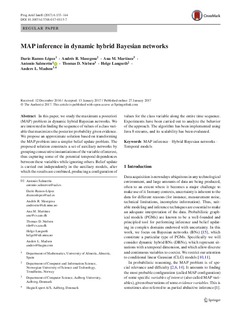| dc.contributor.author | Ramos-López, Dario | |
| dc.contributor.author | Masegosa, Andres | |
| dc.contributor.author | Martinez, Ana M. | |
| dc.contributor.author | Salmeron, Antonio | |
| dc.contributor.author | Nielsen, Thomas D. | |
| dc.contributor.author | Langseth, Helge | |
| dc.contributor.author | Madsen, Anders L. | |
| dc.date.accessioned | 2017-05-30T06:56:22Z | |
| dc.date.available | 2017-05-30T06:56:22Z | |
| dc.date.created | 2017-05-08T11:52:15Z | |
| dc.date.issued | 2017 | |
| dc.identifier.citation | Progress in Artificial Intelligence. 2017, 6 (2), 133-144. | nb_NO |
| dc.identifier.issn | 2192-6352 | |
| dc.identifier.uri | http://hdl.handle.net/11250/2443764 | |
| dc.description.abstract | In this paper, we study the maximum a posteriori (MAP) problem in dynamic hybrid Bayesian networks. We are interested in finding the sequence of values of a class variable that maximizes the posterior probability given evidence. We propose an approximate solution based on transforming the MAP problem into a simpler belief update problem. The proposed solution constructs a set of auxiliary networks by grouping consecutive instantiations of the variable of interest, thus capturing some of the potential temporal dependences between these variables while ignoring others. Belief update is carried out independently in the auxiliary models, after which the results are combined, producing a configuration of values for the class variable along the entire time sequence. Experiments have been carried out to analyze the behavior of the approach. The algorithm has been implemented using Java 8 streams, and its scalability has been evaluated. | nb_NO |
| dc.language.iso | eng | nb_NO |
| dc.publisher | Springer Verlag | nb_NO |
| dc.relation.uri | http://dx.doi.org/10.1007/s13748-017-0115-7 | |
| dc.rights | Navngivelse 4.0 Internasjonal | * |
| dc.rights.uri | http://creativecommons.org/licenses/by/4.0/deed.no | * |
| dc.title | MAP inference in dynamic hybrid Bayesian networks | nb_NO |
| dc.type | Journal article | nb_NO |
| dc.type | Peer reviewed | nb_NO |
| dc.description.version | publishedVersion | nb_NO |
| dc.source.pagenumber | 133-144 | nb_NO |
| dc.source.volume | 6 | nb_NO |
| dc.source.journal | Progress in Artificial Intelligence | nb_NO |
| dc.source.issue | 2 | nb_NO |
| dc.identifier.doi | 10.1007/s13748-017-0115-7 | |
| dc.identifier.cristin | 1468776 | |
| dc.relation.project | EC/FP7/619209 | nb_NO |
| dc.description.localcode | © The Author(s) 2017. This article is published with open access at Springerlink.com. This article is distributed under the terms of the CreativeCommons Attribution 4.0 International License (http://creativecommons.org/licenses/by/4.0/), which permits unrestricted use, distribution,and reproduction in any medium, provided you give appropriate credit to the original author(s) and the source, provide a link to the CreativeCommons license, and indicate if changes were made. | nb_NO |
| cristin.unitcode | 194,63,10,0 | |
| cristin.unitname | Institutt for datateknikk og informasjonsvitenskap | |
| cristin.ispublished | true | |
| cristin.fulltext | original | |

